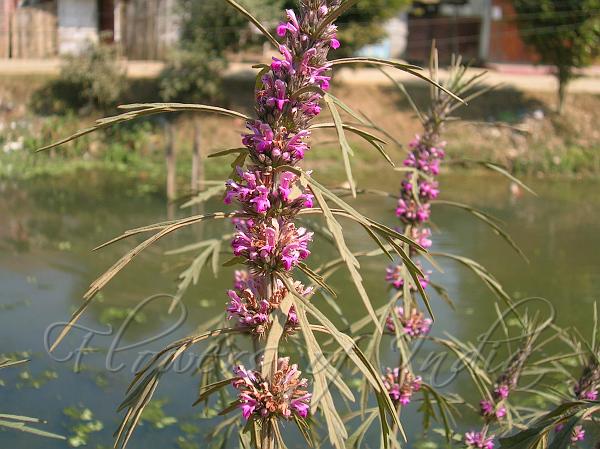|
| Honeyweed |
|

|

| File size | 654603 |
| Original date | 2/1/06 12:55 PM |
| Resolution | 2048 x 1536 |
| Flash | Flash did not fire, auto |
| Focal length | 8.0mm |
| Exposure time | 1/492s |
| Aperture | 3.2 |
| Focus Distance | |
| Metering Mode | Partial |
| Camera make | NIKON |
| Camera model | E3700 |
| Sensor type |
|
|
|
Photo: |
Botanical name: Leonurus sibiricus Family: Lamiaceae (Mint family)
Synonyms: Leonurus multifidus
Synonyms: Leonurus multifidus
Honeyweed is an herbaceous annual or biennial
with upright stems that grow from 20-80 cm tall. Plants have long
stalked basal leaves that are ovate-heart-shaped. The leaves have
toothed margins and are incised with deeply cut lobes. Typically one or
a few flowering stems are produced from short tap-roots. The lower stem
leaves are deciduous and wither away as the plants begin blooming. The
petioles of the leaves, midway up the stems are 2 cm long. The flowers
are produced in many flowered verticillasters, produced in whorls around
the top half or more of the stem. The floral leaves are prominently
3-partite, lobules linear.
The flowers are stalkless, about 1.8 cm long, lower lip about 3/4 as long
as upper lip, calyx densely hairy especially at middle.
Calyxs that are tubular-campanulate in shape. The flowers are white or
reddish to purple-red, with an upper lip that is oblong in shape and
longer than the lower lip. When flowering is done, brown oblong shaped
nutlets are produced in good number. Blooming occurs from July into
late September, but flowering can occur year round when climate permits.
Medicinal uses: In traditional Chinese medicine, the herb is used to
treat loss of potency in men, postpartum bleeding or painful menstruation
in women, and as a diuretic. In Chiapas, Mexico, native
cultures drink the root steeped in tea to aid in menstruation and to
calm other female reproductive system ailments. The leaves are alcohol
soluble; when macerated in alcohol, the tincture may be applied externally
to treat rheumatism or arthritis.
In traditional Chinese medicine, the herb is used to
treat loss of potency in men, postpartum bleeding or painful menstruation
in women, and as a diuretic. In Chiapas, Mexico, native
cultures drink the root steeped in tea to aid in menstruation and to
calm other female reproductive system ailments. The leaves are alcohol
soluble; when macerated in alcohol, the tincture may be applied externally
to treat rheumatism or arthritis.
Medicinal uses:
 In traditional Chinese medicine, the herb is used to
treat loss of potency in men, postpartum bleeding or painful menstruation
in women, and as a diuretic. In Chiapas, Mexico, native
cultures drink the root steeped in tea to aid in menstruation and to
calm other female reproductive system ailments. The leaves are alcohol
soluble; when macerated in alcohol, the tincture may be applied externally
to treat rheumatism or arthritis.
In traditional Chinese medicine, the herb is used to
treat loss of potency in men, postpartum bleeding or painful menstruation
in women, and as a diuretic. In Chiapas, Mexico, native
cultures drink the root steeped in tea to aid in menstruation and to
calm other female reproductive system ailments. The leaves are alcohol
soluble; when macerated in alcohol, the tincture may be applied externally
to treat rheumatism or arthritis.
| Identification credit: J.M. Garg | Photographed in Imphal, Manipur. |
• Is this flower misidentified? If yes,